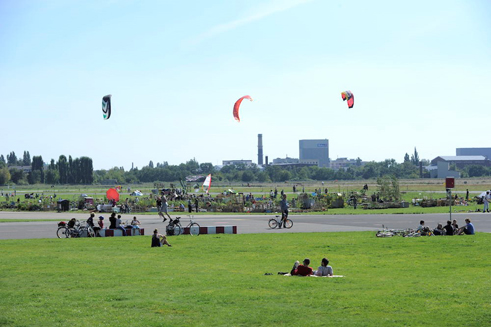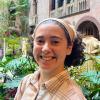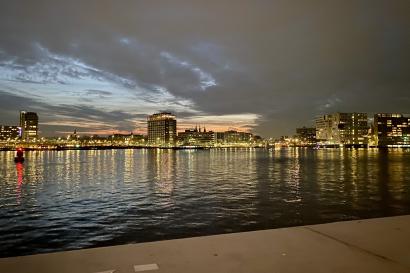
Time flies! It is hard to believe that I have already spent almost two months in Berlin. When my friends from home ask me how my study abroad experiences have been, I always find it difficult to respond anything but “It’s been fantastic. There’s so much to see!” Indeed, immersing in a metropolis filled with rich history, dynamic politics, vibrant arts scene, international and traditional cuisine, and splendid architecture, I cannot fathom a terse response to describe my life in Berlin, including the multiple excursions I took to other German cities and European countries. Therefore, I have decided to begin with the most fundamental aspect of study abroad experience—the daily commute from my host family to IES Abroad Berlin Center where my classes are held. You shall see how just within 8 subway stops and 20-minutes of commute, I can be in touch with Berlin’s modern history and its development. Here are some of the highlights:
My Start: Tempelhof Station
My host family lives one street from a gigantic public park, Tempelhof Field, which used to be the Tempelhof Airport. As people leisurely enjoy the spacious field for barbeques, skate-boarding and jogging today, it is thrilling to remember that 80 years ago, amid the tensions and urgency of the Berlin Blockade, the Allied force was dropping millions of tons of care packages into this very airport, as the Soviet halted all traffic by land and water into West Berlin. It is claimed that every minute, there was a plane landed at the Tempelhof Airport.
Besides its historical significance of resistance and tenacity of West Germany and the of support from the allied forces, Tempelhof Field is also an interesting piece of architecture, with an elongated curve structure and massive space within the main building. Through my Urban Studies class, I learned that the airport was originally commissioned by the Nazi government in the 1920s—a part of the historical narratives that are lesser mentioned nowadays. The then government refused to apply the modern design on monumental and governmental buildings, which is why the front of the airport assumes a classical stone façade. Ironically, however, the back of the airport is indeed modern, with steel frames exposed and extended to the plane parking area.
Decades after decades, different people came and left this airport with different emotions and ambitions. As I pass through the Tempelhof Field every morning, I am reminded of all the tear and laughter that happened here, feeling blessed for the life I have today.
Platz der Luftbrücke
Continuing the legacy of Tempelhof, Platz der Luftbrücke is a landmarked square where the Berlin Airlift Monument is located. The monument is dedicated to those who died in the process of delivering goods to West Berlin during Berlin Blockade. When I first saw the monument, it reminded me of a claw ( which proves to be its “nickname” given by Berliners too). The three prongs on the curved concrete surface, in fact, represent the three air corridors between West Germany and West Berlin used during the airlift. Fun fact--there is an identical monument in Frankfurt, Germany that faces the one in Plaz der Luftbrücke, resembling the flight routes from Frankfurt to West Berlin.
The station was named Kreuzberg from 1928-1931. In fact, not far from Plaz der Luftbrücke is the Kreuzberg district, one of the most popular areas for young people to enjoy their nightlife.

Kochstrasse (Checkpoint Charlie)
My train also rides past the famous Checkpoint Charlie, a historical checkpoint for the entrance of foreigners into East Germany. Nowadays once you exit the stations, arrays of souvenir stores selling Allied flags would make you forget, momentarily, about the animosity and gloominess of the city’s past.
My destination: Oranienburger Tor
I get off every day at Oranienburger Tor, which means Oranienburger Gate in German. The subway station is a 5-minute walk from IES Berlin Abroad Center and located in Mitte, the center of Berlin. Around this station, one can observe a variety of international cuisine, a theatre that screened dozens of films during the Berlin Film Festival and many small exciting shops. There is a large construction space going on next to the station, with walls of older buildings half torn down and half painted in creative graffiti. One of the faculty at IES Abroad said on the first day of my program, “There is always construction going on in Berlin.” While the new modern buildings are being erected around the city, the history of this metropolis is deeply engraved in every street and every subway stops. Berlin is such a unique place that the old and the new, yesterday and today, are tightly interwoven, delivering an unparalleled cultural rhythm to the world.

Hannah Shen
<p class="MsoBodyText" style="margin-top:2.35pt; margin-right:8.35pt; margin-bottom:.0001pt; margin-left:5.0pt"><span style="line-height:115%">Hi, my name is Hehe Shen and I am a junior studying Government at Harvard University. I lived in Shanghai, China for 18 years and New York City for a year before going to college in Cambridge, Massachusettes. One fun fact--many people thought I was joking when I told them my name is "Hehe" (it is correctly pronounced as Huh-Huh in Mandarin and means grandeur). It is funny how the meaning of my name is lost in translation and assumes a new hilarious image. Academically, I am very interested in comparative politics in Asia-Pacific as well as global governance. In the past four years, I have been involved in running international education conferences in China that introduces liberal arts education to 1000 Chinese high school students. In my spare time, I enjoy making latte art, wine tasting, cycling and traveling. As a coffee addict, I spent four months working at a special cafe in Shanghai to be a semi-professional barista.</span></p>









